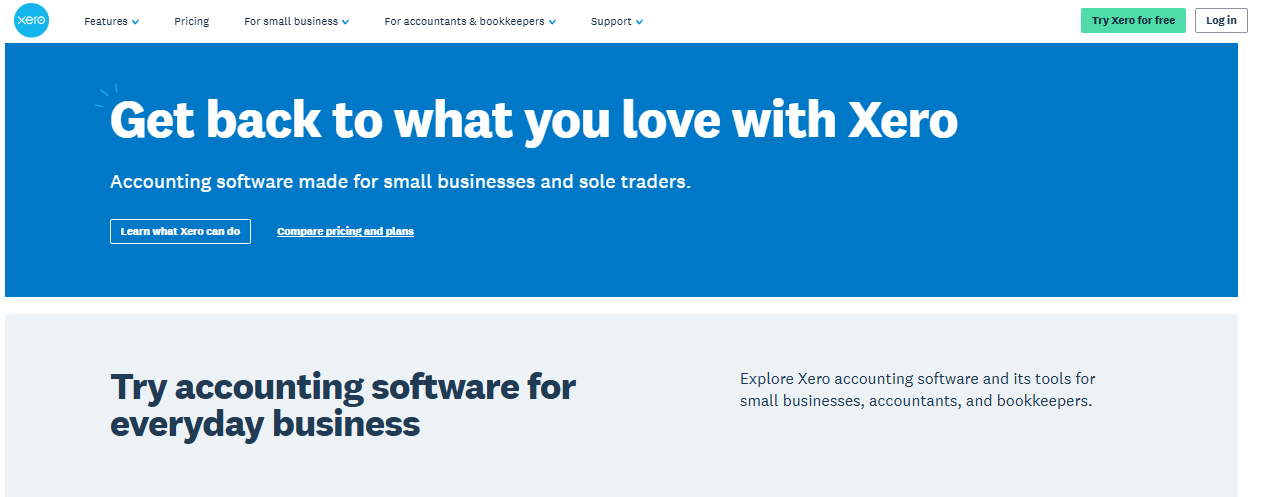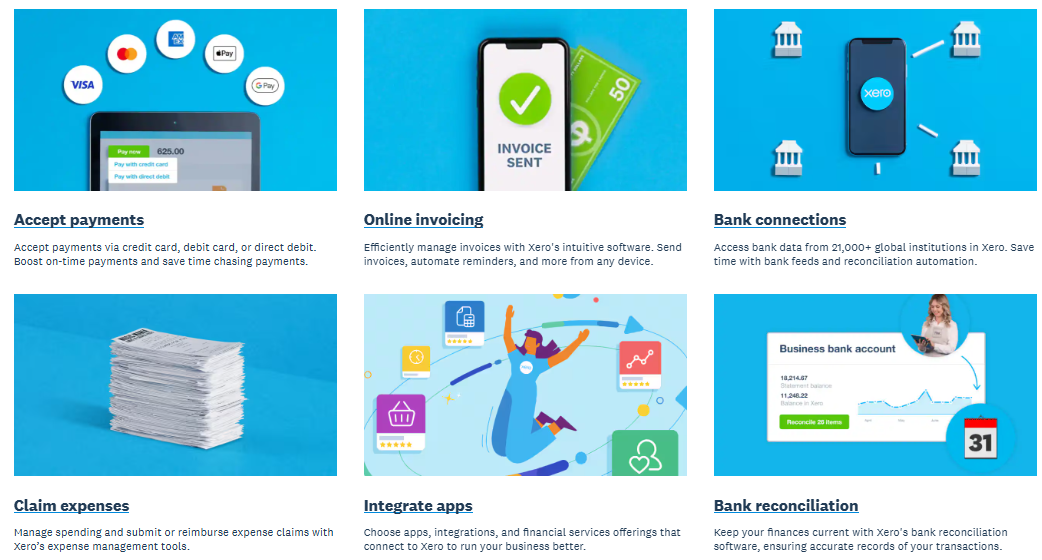Is Xero the Right Accounting Software for You? (Comprehensive Review)

When it comes to accounting software, business owners want something that makes their lives easier, not harder. That’s where Xero comes in. Designed to help small and medium-sized businesses handle finances smoothly, Xero offers a ton of features, from invoicing and bank reconciliation to project tracking and multi-currency support.
But is it the right fit for your business? Let’s dive deep into Xero’s features, pricing, pros and cons, and how it stacks up against competitors. By the end, you’ll have a clear idea of whether Xero is the best accounting software for your needs.
What is Xero?

Xero is a cloud-based accounting software platform designed for small and medium-sized businesses. Founded in 2006 in New Zealand, Xero has grown into one of the leading accounting solutions worldwide, serving millions of businesses across various industries. It enables business owners, accountants, and bookkeepers to manage financial data efficiently in real-time from any internet-connected device.
Xero is built on a cloud infrastructure, meaning users can access their accounts from anywhere without installing software on their local computers. It integrates with banks, allowing automatic transaction imports for easy reconciliation. The platform also connects with a vast ecosystem of third-party applications, enhancing its functionality for different business needs such as payroll, inventory management, and customer relationship management.
Xero follows a subscription-based model, offering different pricing plans depending on the size and needs of the business. This model makes it accessible to startups, freelancers, and established companies looking for a scalable accounting solution. The platform supports multi-currency transactions, making it suitable for businesses operating internationally.
One of Xero’s key aspects is its automation capabilities, reducing manual data entry and minimizing errors. It allows businesses to generate financial reports, send invoices, track expenses, and manage cash flow seamlessly. Accountants and financial advisors can collaborate within the platform, streamlining bookkeeping and tax preparation processes.
Security is a priority for Xero, with features such as data encryption and two-factor authentication ensuring financial information remains protected. As a cloud-based solution, Xero regularly updates its platform to comply with changing financial regulations and industry standards.
Overall, Xero is a widely used accounting software that simplifies financial management for businesses. Its cloud-based approach, accessibility, and ability to integrate with various applications make it a preferred choice for many business owners and financial professionals worldwide.
Features: What Can Xero Do for You?

Whether you’re a small business owner, freelancer, or managing a growing company, Xero offers a range of features to simplify accounting and improve financial transparency. Here’s a detailed look at some of its key features and how they can benefit your business.
1. Accept Payments
One of the biggest challenges businesses face is late payments. Xero makes it easier to get paid on time by enabling customers to pay directly via credit card, debit card, or direct debit. By integrating with payment services like Stripe, PayPal, and Square, Xero allows businesses to offer multiple payment options, making transactions seamless for clients. Faster payments mean improved cash flow, reducing the stress of unpaid invoices and awkward follow-ups.
2. Online Invoicing
Xero’s online invoicing system simplifies the billing process. You can create and send professional invoices in minutes, set up automatic reminders for overdue payments, and track payments in real time. The ability to customize invoices with your branding ensures a consistent and professional look. Plus, with mobile accessibility, you can send invoices on the go, making it easier to manage finances from anywhere.
3. Bank Connections & Reconciliation
Manually entering transaction data can be tedious and time-consuming. Xero connects with over 21,000 banks worldwide, automatically importing and categorizing transactions. This eliminates manual data entry errors and speeds up the reconciliation process. With bank feeds pulling real-time transaction data, businesses can stay up-to-date with their cash flow, making informed financial decisions without delay.
4. Expense Management
Keeping track of business expenses is crucial for budgeting and tax preparation.Xero’s expense management tools allow users to record and categorize expenses, submit and approve claims, and attach receipts digitally. Employees can also submit expense claims via the Xero mobile app, making it easy to manage reimbursements on the go. This feature helps businesses maintain accurate financial records and gain insights into spending habits.
5. Integrations
Modern businesses use multiple tools to manage different aspects of operations, from customer relationship management (CRM) to inventory tracking. Xero integrates with hundreds of third-party apps, including Shopify, HubSpot, Zapier, and Gusto. These integrations allow businesses to sync their accounting data seamlessly, reducing duplicate data entry and improving overall efficiency. Whether you’re running an eCommerce store or a service-based business, Xero’s integrations enhance workflow automation.
6. Bill Payments
Managing payables efficiently ensures suppliers are paid on time and helps maintain good business relationships. Xero lets you track and schedule bill payments, set up recurring payments, and view upcoming due dates in a centralized dashboard. Automated reminders and batch payment processing further simplify bill management, preventing missed payments and helping maintain healthy cash flow.
7. Project Tracking
For businesses that work on a project basis—such as freelancers, agencies, and consultants—Xero offers project tracking tools to monitor time, costs, and profitability. Users can create detailed project budgets, track billable hours, generate quotes, and convert them into invoices with a few clicks. This feature ensures businesses can accurately charge clients and maintain profitability while keeping projects on schedule.
8. Payroll
Managing payroll can be complex, especially for small businesses. Xero’s payroll functionality simplifies pay runs, employee record-keeping, and tax calculations. It allows for automatic tax filings, direct deposits, and employee self-service portals where staff can access their pay slips. Although Xero’s payroll tools are designed for small businesses, they integrate with third-party payroll providers for companies that require advanced payroll features.
9. Purchase Orders
Keeping track of supplier purchases is essential for inventory-based businesses. Xero allows users to create, send, and manage purchase orders seamlessly. You can track order statuses, monitor deliveries, and match invoices with purchase orders to ensure accuracy. This feature helps businesses maintain inventory levels efficiently while avoiding overstocking or understocking issues.
10. Reporting & Analytics
Understanding business performance is crucial for making strategic decisions. Xero provides comprehensive financial reports, including profit and loss statements, balance sheets, and cash flow reports. Customizable dashboards give users an overview of their financial health at a glance. These insights help business owners identify trends, assess profitability, and make data-driven decisions for future growth.
Additional Features
Beyond these core features, Xero offers several other tools to enhance business operations:
- Inventory Management: Track stock levels, manage product sales, and generate purchase orders to streamline inventory control.
- Multi-Currency Support: Businesses that operate globally can handle transactions in multiple currencies with real-time exchange rate updates.
- Sales Tax Calculations: Automate tax calculations, ensuring compliance with local and international tax regulations.
- Online File Storage: Store and manage financial documents, receipts, and contracts securely within Xero.
- Customizable Chart of Accounts: Tailor account structures to fit business needs and enhance financial reporting accuracy.
Why Xero Matters for Businesses
Xero’s cloud-based nature means businesses can access their financial data from anywhere, allowing for real-time collaboration with accountants and financial advisors. Its automation capabilities reduce the time spent on administrative tasks, freeing up business owners to focus on growth. Security is also a top priority, with built-in encryption and two-factor authentication ensuring data remains protected.
For startups, freelancers, and growing businesses, Xero offers a scalable solution that adapts to changing financial needs. With a user-friendly interface and a broad ecosystem of integrations, Xero simplifies financial management, making it an invaluable tool for businesses worldwide.
Pricing: How Much Does Xero Cost?

Xero offers three pricing tiers, making it accessible for businesses of all sizes. Each plan provides essential accounting tools, with higher tiers offering more advanced features.
1. Starter Plan
- Regular Price: $29/month
- Limited Offer: $2.90/month (for 3 months)
- Features: Includes 20 invoices/quotes, 5 bill entries, bank reconciliation, and short-term cash flow projection.
2. Standard Plan
- Regular Price: $46/month
- Limited Offer: $4.60/month (for 3 months)
- Features: Offers unlimited invoices/quotes, unlimited bill entries, bank reconciliation, and short-term cash flow projection.
3. Premium Plan
- Regular Price: $69/month
- Limited Offer: $6.90/month (for 3 months)
- Features: Includes everything in the Standard Plan plus multi-currency support.
Add-Ons
Xero also offers additional features to enhance business operations. Add-ons like expense claims and project tracking start at just $4/month, allowing businesses to customize their accounting experience based on their needs. With flexible pricing and a range of features, Xero provides a scalable solution for businesses looking to simplify their financial management.Pros and Cons: The Good and the Bad
Pros
- User-Friendly Interface
- Strong Integrations
- Automated Bank Feeds
- Comprehensive Reporting
- Scalable Plans
Cons
- Learning Curve
- No Native Phone Support
- Limited Payroll Features
- Starter Plan Limitations
- Occasional Bank Feed Delays
Pros:
User-Friendly Interface: Xero’s dashboard is clean, modern, and intuitive, making it easy for users to navigate, even without prior accounting experience.
Strong Integrations: Xero integrates seamlessly with over 1,000 third-party apps, including CRM tools, payment processors, inventory management software, and eCommerce platforms.
Automated Bank Feeds: Xero connects with thousands of banks worldwide, pulling in transaction data automatically and saving users time on reconciliation.
Comprehensive Reporting: Offers detailed financial reports and real-time insights into business performance, helping owners make informed decisions.
Scalable Plans: Xero provides multiple pricing plans, allowing businesses to upgrade as they grow and require more advanced features.
Cloud-Based Access: Since Xero is cloud-based, users can access their financial data from anywhere, making remote work and collaboration easy.
Customizable Invoicing: Users can create professional invoices with their brand logo and automated payment reminders.
Multi-Currency Support: Available in the Premium Plan, making it a great option for international businesses dealing with multiple currencies.
Cons:
Learning Curve: While Xero is user-friendly, some advanced features, such as financial reporting and multi-currency handling, require a learning curve.
No Native Phone Support: Customer service is primarily offered via chat and email, which can be inconvenient for users who prefer direct phone support.
Limited Payroll Features: Xero’s payroll capabilities are basic and may not be suitable for businesses with complex payroll needs or larger teams.
Starter Plan Limitations: The lowest-priced plan limits users to 20 invoices/quotes and 5 bill entries per month, which may not be sufficient for growing businesses.
Occasional Bank Feed Delays: While bank connections are automated, some users report occasional delays in data syncing, which may impact real-time tracking.
Despite a few limitations, Xero remains a powerful and scalable accounting solution for small to mid-sized businesses looking for an intuitive and feature-rich platform.
Xero vs. Competitors: How Does It Compare?

Xero vs. QuickBooks Online
- Ease of Use: QuickBooks Online is often considered more beginner-friendly due to its guided setup and intuitive interface. However, Xero provides more flexibility, making it ideal for businesses that plan to scale.
- Pricing: Xero’s pricing plans are generally more affordable than QuickBooks, especially with its introductory discounts. This makes it a cost-effective choice for small businesses.
- Features: Both platforms offer essential accounting features, such as invoicing, expense tracking, and bank reconciliation. However, QuickBooks Online has stronger built-in tax tracking tools, making it a better option for businesses that prioritize tax compliance and reporting.
- Integrations: QuickBooks Online supports a wide range of third-party integrations, but Xero has a broader ecosystem with over 1,000 app integrations, giving businesses more customization options.
Xero vs. FreshBooks
- Target Audience: FreshBooks is primarily designed for freelancers and small service-based businesses, offering a streamlined invoicing system. Xero, on the other hand, is built for businesses of all sizes, including larger enterprises that require advanced financial management.
- Invoicing: FreshBooks is well-known for its invoice-focused approach, providing user-friendly tools for creating and managing invoices. Xero includes invoicing as part of its broader accounting suite, making it a more comprehensive financial solution.
- Expense Management: While both platforms offer expense tracking, Xero’s automation features, such as bank feeds and AI-driven categorization, provide a more efficient workflow for managing expenses at scale.
Xero vs. Wave
- Pricing: Wave is a completely free accounting software, which makes it an attractive choice for freelancers and very small businesses. However, it lacks many of the advanced features that Xero offers, such as multi-currency support and detailed financial reporting.
- Scalability: Xero is a better choice for growing businesses, as it provides more advanced tools for managing multiple accounts, handling payroll, and integrating with business apps. Wave is best suited for solo entrepreneurs who need a simple bookkeeping tool.
- Support & Features: While Wave offers essential accounting functions, it does not provide as many integrations or automation tools as Xero. Businesses looking for a long-term solution with scalability and advanced financial tracking will benefit more from Xero.
Overall, Xero stands out as a flexible and scalable accounting platform that competes well with QuickBooks, FreshBooks, and Wave, depending on business needs and budget.
Final Verdict: Is Xero Worth It?
If you’re looking for a powerful, cloud-based accounting solution that streamlines financial tasks and integrates well with other business tools, Xero is a fantastic choice. It offers strong automation, useful reporting, and excellent bank integration.
However, if you’re a freelancer needing basic invoicing, a tool like FreshBooks or Wave might be better. Likewise, if you need advanced tax tracking, QuickBooks could be worth considering.
Whether you’re a freelancer or a business owner, our guide to finance tools can help you choose the best accounting software.
Bottom Line: If you want a scalable, feature-packed accounting platform, Xero is definitely worth trying.
